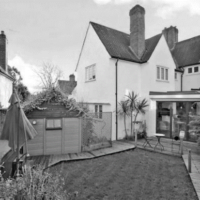Are you thinking of building, or commissioning the build of, your own home?
Glossy magazines and TV shows like BBC 2’s Building Dream Homes and Channel 4’s House of the Year and Grand Designs often inspire us with beautifully designed new homes that individuals have built themselves to suit their needs. Self-build is increasing in popularity- it can be cheaper than buying an existing dwelling, but also allows you to design a bespoke space to suit your family’s needs. In acknowledging the growing demand for self-build plots and making recommendations to make this easier, the Housing White Paper (Feb 2017) referenced Ipsos MORI polls, indicating that more than a million people in the UK expect to buy a plot, secure planning permission or start/complete construction work on their new home. If you have aspirations for creating your dream home, the first step would be to find the perfect plot of land. This can become a frustrating and lengthy part of the process, due to complex planning regulations. Should this be the case we can help. Fuller Long can assist you in providing planning advice and guidance from the inception of your project through to getting planning permission.
Find out more about me here
If you are looking to build your own home in a city or town location, the plots can often be awkwardly shaped and surrounded by existing homes which overlook the vacant land. In seeking to protect the light and outlook from those existing homes, the Council will restrict the size and scale of any new building. Alternatively, you might be looking for a rural plot of land with stunning views of the countryside. However, many Councils resist new development in rural locations, as they want to protect the undeveloped character of the countryside.
Don’t give up hope though. With a little creative thinking, most planning obstacles can be overcome. For example, basement homes or homes partly sunk down to reduce their height are increasingly common in both urban and rural locations as a way of overcoming planning restrictions.
In urban areas, reducing the height of a building assists in protecting the outlook and light of existing neighbouring homes, and ensures that a new-build is subservient to more established buildings. A superb example of the extensive use of basement levels to create a substantial home on an constrained city plot is 29 Russell Garden Mews designed by Hogarth Architects (https://openhouselondon.open-city.org.uk/listings/6863), which featured on Channel 4’s Grand Designs. This family home has a large living space in the basement, using a courtyard and light reflective paint to maximise the natural light in the space.
extensive use of basement levels to create a substantial home on an constrained city plot is 29 Russell Garden Mews designed by Hogarth Architects (https://openhouselondon.open-city.org.uk/listings/6863), which featured on Channel 4’s Grand Designs. This family home has a large living space in the basement, using a courtyard and light reflective paint to maximise the natural light in the space.
In the countryside, basement or part-basement homes can hide the bulk of a new building and reduce its impact on wider views. A beautiful example of a hidden underground home in the countryside is Bigbury Hollow in Kent, designed by Hawkes Architecture (https://www.kentonline.co.uk/canterbury/news/a-grand-design-thats-out-131099/), which also featured on Grand Designs. The home is located in a former quarry, and ensures sufficient light reaches the living spaces by siting them in two wings separated by courtyards.
Or if the price tag of a bespoke architect-designed underground home is out of reach for you, then you could consider something pre-fabricated, such as a Green Magic Home (https://greenmagichomes.com/) from the USA. These are pre-fabricated components which arrive ready to be covered with soil and planting to create a fun and unique hobbit-style house!

Although Councils often resist new homes in the countryside, National Planning Policy does allow for some exceptions where there are special circumstances, such as “the exceptional quality or innovative nature of the design of the dwelling”. Interpretation of this can vary from Council to Council, but generally this means that the building will not only be highly sustainable and efficient, but the design will need be truly unique, reflecting the distinctiveness of the site and locality.
Councils are required to ensure that they are providing enough plots to meet the demand for self-build plots in their area. But how do they know how much land is needed, and where?
To help the Council quantify demand and make sure they are allocating enough land, they must maintain a custom and self-build register in their areas. This is essentially a list of people seeking to acquire land for self-build development in the area. Note that some Councils may put restrictions on who can apply to be on the list – for example they might want to prioritise self-builders with a local connection. It is worthwhile putting yourself forward for your local self-build register as without that information, the Council will not have an accurate picture of demand to assist them in allocating new plots.
Land that has been allocated by a Council for self-build units will often be a more straightforward prospect than finding an undeveloped plot yourself. Firstly, as it will be allocated for housing by the Council, there won’t be any issues surrounding the principle of building your home. Second, these sites will often be provided as part of a wider development and will be offered for sale as ready serviced, so you won’t have to worry about access and utilities provision. An example of a large scale Council allocation for self-build projects is Graven Hill in Oxfordshire, where Cherwell Council have allocated land for 1,900 new self-build plots (https://gravenhill.co.uk/).
If you are thinking about a self-build project or have encountered a planning obstacle that you need help overcoming in your self-build project, then contact us today on 0808 164 1288 for a no obligation conversation or email us at hello@fullerlong.com
Sources:
https://www.gov.uk/government/publications/fixing-our-broken-housing-market
https://researchbriefings.parliament.uk/ResearchBriefing/Summary/SN06784#fullreport
https://www.gov.uk/guidance/self-build-and-custom-housebuilding
https://openhouselondon.open-city.org.uk/listings/6863
https://www.kentonline.co.uk/canterbury/news/a-grand-design-thats-out-131099/





